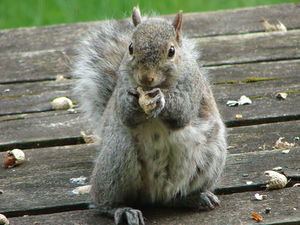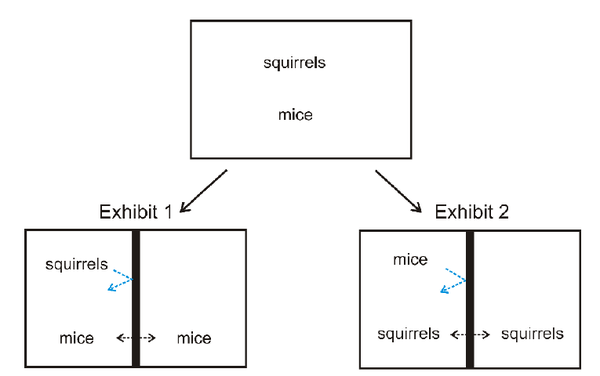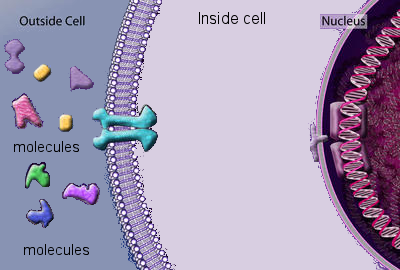Zoo exhibit activity
The following is an interactive activity, in which students design two zoo exhibits for mice and squirrels. The exhibit cages contain two chambers; one exhibit is to allow squirrels to pass back and forth between the chambers, while keeping the mice confined to one chamber; conversely, the other exhibit will allow mice to pass back and forth while confining the squirrels to one side. This can be used in several ways. The shorter version functions simply as an open-ended, stand-alone communicative activity for producing English, while the full version (i.e., with the follow-up activity) can serve as a science lesson as well.
- This can be used as a stand-alone interactive activity to get students to work in groups, describing procedures, devices and animals in English. In this case, it is simply an open-ended communicative activity.
- This can lead to class presentations, where student groups present their best ideas to the class.
- The group activity with or without presentations (without the follow-up) can be good for students in engineering and science fields.
- This can be extended further with the follow-up activity below for a biology lesson, as this was originally developed for biology students (see background section). This would be suitable for those majoring in biology / life sciences, medicine, health sciences, pharmacology, nursing, or bio/molecular engineering.
- The activity itself or the follow-up can also include discussion of relevant academic English words, including stress patterns in those words (and squirrel is hard for East Asian students to pronounce, so they can also practice the /r/ sound).
Contents
1 Background
This was designed originally as an invention activity, a kind of discovery learning activity in which students discover a principle through the process of inventing something. This in turn was designed as an analogy for an important biology principle (which can be done with the follow-up activity below). This zoo activity was first designed by Taylor, Smith, van Stolk & Spiegelman (2010)[1]
Taylor and colleagues, and previous studies, have found that undergraduate students have difficulty with the concept of cell membrane functions, namely, cell membrane permeability. Cells have various sophisticated mechanisms for allowing certain molecules into cells while keeping out undesirable molecules. This is known as cell membrane permeability, and various studies (see Taylor et al.) found that undergraduate students tended to forget these concepts after learning them in their basic biology courses. In an EFL context, this problem can be compounded by EFL difficulties and pure lecture-based learning in their cell biology courses, which inhibits conceptual learning.
2 Procedures
2.1 Zoo exhibit task (30+ min.)
A handout with basic details and graphics is distributed (see below). In groups, students are to design two potential zoo exhibits; Exhibit #1 allows mice to pass freely between two compartments while restricting squirrels to one, and another (#2) confines mice to one side while allowing squirrels to pass freely. Their task is to think of multiple ways of designing compartments to do so.
2.2 Discussion [10+ min.] or Presentation (30+ min.)
As a whole class, the groups share their ideas, with feedback from the instructor. Alternatively, groups present their best ideas to the whole class as a presentation assignment, which can be graded (if desired).
2.3 Part 2: Cell task (optional follow-up science activity) (20+ min.)
Students are provided a simplified diagram of a cell membrane, and pictures of molecules of different shapes and sizes (they need not be actual or identified chemicals). They are given the following challenge:
- Segue question: Now think about biological cells. What kinds of things go in and out of cells? What kinds of chemicals should be allowed or prevented from entering?
- Cell membranes must allow various molecules to pass or to not pass at certain times. Other chemicals need to be prevented from entering. How might you design cell “doors” that would do this?
3 Materials
A handout with the following information and pictures is provided. [2] The original materials are available from Taylor & colleauges' website[3].

|

|
| Squirrel 25 cm long, 8 cm wide 800 g |
Mouse 7 cm long, 2 cm wide 20 g |
4 Instructions
Students are to design two zoo exhibits for squirrels and mice. Each cage or exhibit has a partition to separate the animals. In Exhibit 1, the mice can move freely between both compartments, but the squirrels are restricted to one side. In Exhibit 2, the squirrels can move freely between both compartments, but the mice are restricted to one side. The designs must meet the following conditions.
- The animals cannot be hurt in any way. The design cannot use cats or anything that would cause harm or emotional stress to the animals. (Since this is a zoo exhibit, children will see it, and they won't want to see animals being harmed or distressed.)
- The animals cannot be restrained -- e.g., they cannot be tied or restrained in any other way.
- There are multiple squirrels and multiple mice; no solitary animals.
- Students are free to decide on the design, dimensions, and materials used for the exhibit, cage, or partitions.
- Students can make use of extra information that they look up about squirrels and mice, e.g., their eating habits, climbing or swimming abilities, etc.
- The designs can involve physical designs, mechanical devices, simple electronics, or other reasonable methods. They cannot involve anything unrealistic or extremely hi-tech, such as genetically modified animals, DNA scanners, or advanced engineering technology.
For Exhibit 1, an obvious solution is a simple 2 cm hole for only the mice to pass through. However, the groups cannot just propose this idea, since this is so obvious; more creative ideas will be needed.
5 Presentations
Students will work in groups to come up with the best ideas. Then the group will present their ideas to the class, with each person presenting at least one idea. The group component of the grade is based on collectively coming up with the best ideas possible, and giving equitable and balanced presentations, e.g., so that each presenter's presentation time is not excessively longer or shorter than the others in his/her group. Each person presents one of the group's ideas, so each group should present at least 2-3 ideas for Exhibit 1, and 2-3 ideas for Exhibit 2, depending on the group size.
6 Evaluation
In my class, each person gets an individual presentation grade (a minor grade), and a group grade for overall group performance (also a minor 10-point grade). Presenters and groups are graded based on the following criteria:
- Creativity, originality
- Clear explanations
- Sufficient details & contents
- Clear speaking & vocal delivery
- Equal work and contributions by each member
- Media: Good use of PPT, whiteboard, handouts, or other aids (For this, I only require using the whiteboard.)
- Feasibility or practicality of ideas
I expect that each person's presentation should take at least one minute, approximately, though this may vary depending on the complexity of the ideas. You can adapt the grading, length, and requirements to your teaching needs and student levels.
7 Follow-up: Cell membranes
The following connects the zoo activity to its original biological aim as Taylor et al. proposed it. This requires the teacher to be familiar with cell membrane permeability. If not, s/he can skip this and do the vocabulary and pronunciation component.
7.1 Cell task
The following is a simplified diagram of a cell membrane, with molecules floating outside the cell and a membrane gate.
- Now think about biological cells. What kinds of things go in and out of cells? What kinds of chemicals should be allowed or prevented from entering?
- Cell membranes must allow various molecules to pass or to not pass at certain times. Other chemicals need to be prevented from entering. How might you design cell membrane gates that would do this?
7.2 Vocabulary for cell task
What do these mean in relation to cell membranes? Try to guess the pronunciation.
| 1. | potassium, sodium, calcium potential, interstitial |
differentiate, potentiate ionization, potentiation, differentiation |
| 2. | electric, acidic, metabolic nucleic |
electrical biological, cytological permeability, stability, alkalinity |
| 3. | transfer, amino, ion, protein, membrane, glucose |
biology, cytology molecule, permeable, semipermeable |
| 4. | cell membrane ion channel sodium ion ion pump |
ion transport action potential amino acid lipid layer |
8 Follow-up 2: Academic English vocabulary, & pronunciation
8.1 Practicing stress and vowel patterns
Words like the following may be presented before/with Part 2. After the discussion in Part 2, these prosodic patterns can be practiced. In these cases, the main lexical stress falls on the syllable before the i-stem suffix, e.g., before -ion, -ium, -ity.
| Stress patterns | Vocabulary provided to students | |
|---|---|---|
| 1. | Stress on syllables before i-stem suffixes (-ium, -tion, -ion) |
potassium, sodium, calcium, ionization, potentiation |
| 2. | Stress on syllables before -ity, -ic | permeability, biological |
| 3. | Stress tends to fall on second or third syllables from end[4] | transfer, amino, ion, protein, membrane, glucose |
| 4. | Compound stress patterns | ion channel, sodium ion, ion transport, action potential, amino acid, cell membrane |
| 5. | Long /ɔʊ/, /ei/ | amino, sodium, glucose, protein, potentiation, membrane |
These and other words can be provided on a handout (just the right column, categorized like above), and in groups students are to guess where the main stress lies for #1-4. The instructor then guides them in a brief pronunciation practice. For #4 above: In English compound nouns, the main stress usually falls on the first word of a compound. For #5: East Asian students have trouble pronouncing these long English vowels - the long /ou/ as in boat, and the long /ei/ as in bait; exaggerated repetition and practice may be helpful here.
8.2 Review
In groups, students explain to each other in English the basic concept of how cell membrane permeability works, using the vocabulary above.
9 Adaptations
This could be split into two class sessions, with more time allocated for students to develop ideas in groups (zoo & cell tasks) and for whole-class discussion of ideas.
9.1 Lower levels
- Pre-teaching vocabulary for zoo exhibit (e.g., terms related to animals, animal bodies, containers, materials, surfaces, surface textures, simple devices)
- Pre-teaching the tongue position and pronunciation of /r/ and /ə/ (squirrel), and /z/ in plurals after voiced consonants (squirrels).
- Pre-teaching vocabulary and providing vocabulary on a handout for Part 2.
- Mention of the (-2/-3) stress pattern can be omitted here, though the articulation of stresses (syllable length & intonation) for some words can still be practiced.
9.2 Higher levels
- After the group work component of the zoo exhibit task, neighboring groups in the classroom join together to share and critique each other’s ideas, and point out potential problems. They then return to their groups to refine or further develop ideas. [10 min.]
- Similarly, after the cell task, they can compare and critique ideas.
- After practicing the initial vocabulary list in Part 2, students can be given a second list with more technical terms for further practice.
- The Greek stress pattern can be mentioned, e.g., cytoplasm, protoplasm. This involves main stress on the fourth or third syllable from the end, which effectively ends up being on the first syllable.
- For the review task, students can also write out a one-paragraph explanation in their own words, at the end of class or for homework.
10 Outcomes
- Students will understand the basic concept of cell membrane permeability, and be able to explain it very basically in English.
- Students can predict and pronounce the stress patterns of academic words with certain endings.
- Students can be aware that they need to articulate stress patterns (vowel duration & intonation) more clearly.
- Students will be aware that the “Konglish” pronunciations of /ɔʊ/, /ei/ are not the same as in standard English.
11 References & notes
- ↑ Taylor, J. L, Smith, K. M., van Stolk, A.P. & Spiegelman, G. B. (2010). Using invention to change how students tackle problems. CBE—Life Sciences Education, 9, 504-512.
- ↑ This is adapted from a conference handout by Taylor, Spiegelman, & Smith, and the exhibit graphic below is is directly from their handout and website materials. Jared Taylor, George Spiegelman,& Karen M. Smith. (2010). Invention Activities for Small Group Learning in First Year Biology. Presentation at ISSOTL Conference, Liverpool, UK, 19 Oct. 2010.
- ↑ CSWEI: Carl Wieman Science Education Initiative, University of British Columbia. http://www.cwsei.ubc.ca/resources/other.htm - Activities for science education; resources for science teaching; educational studies of science teaching; and a zip file of invention activities for biology by Jared Taylor. The zip file includes (1) a guide for instructors; (2) handouts; (3) follow-up homework assignments; and (4) PPT slides that can be freely used.
- ↑ This is the Latin penultimate / antepenultimate stress pattern, where the main stress tends to fall on the second or third syllable from the end, or "-2" and "-3" in the way I present it. This is my own way of designating syllable positions for pedagogical purposes. English lexical stress assignment depends on suffixes and end syllables, and thus, I refer to “-1, -2, -3...” syllable positions for final, penultimate, antepenultimate, etc. positions.

